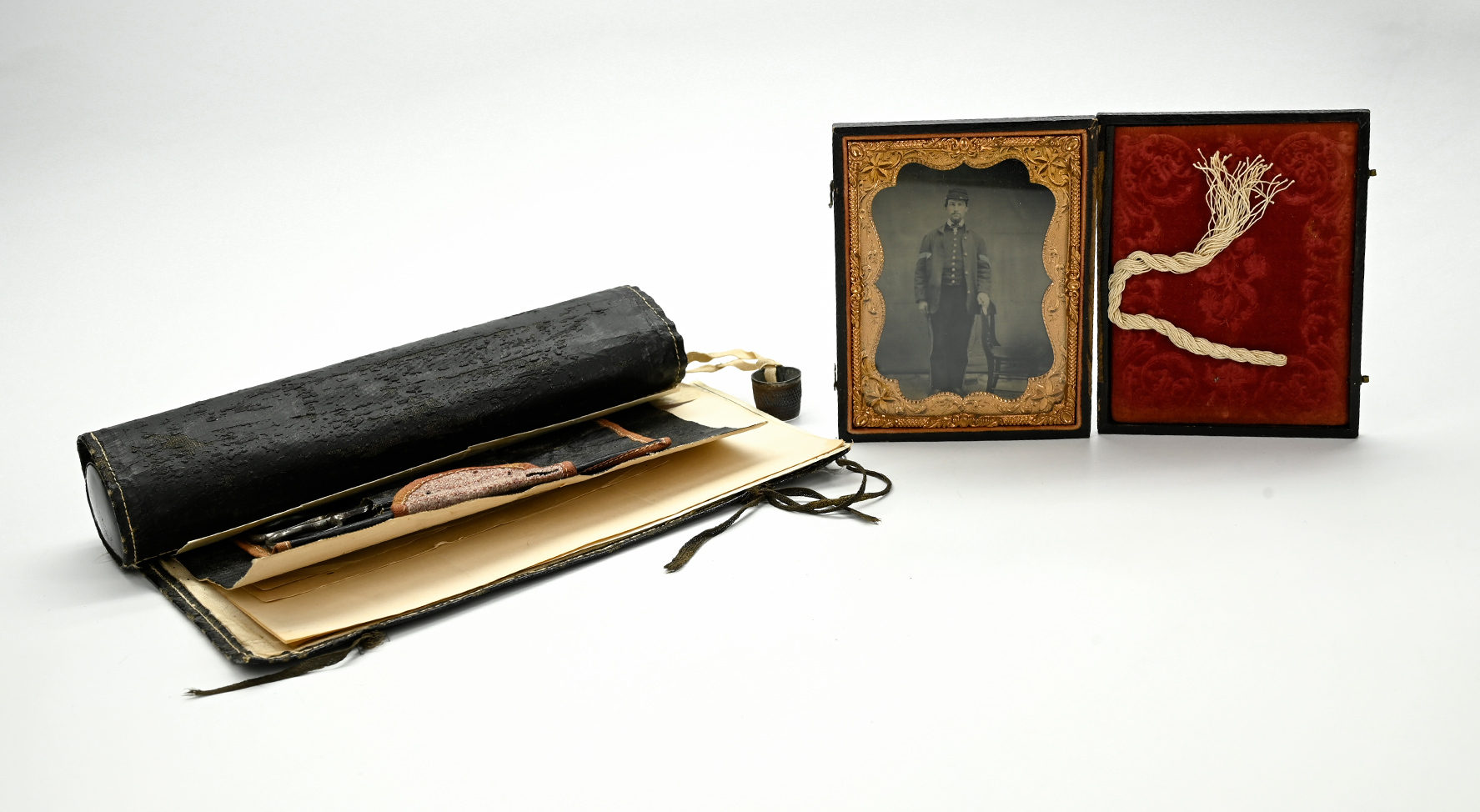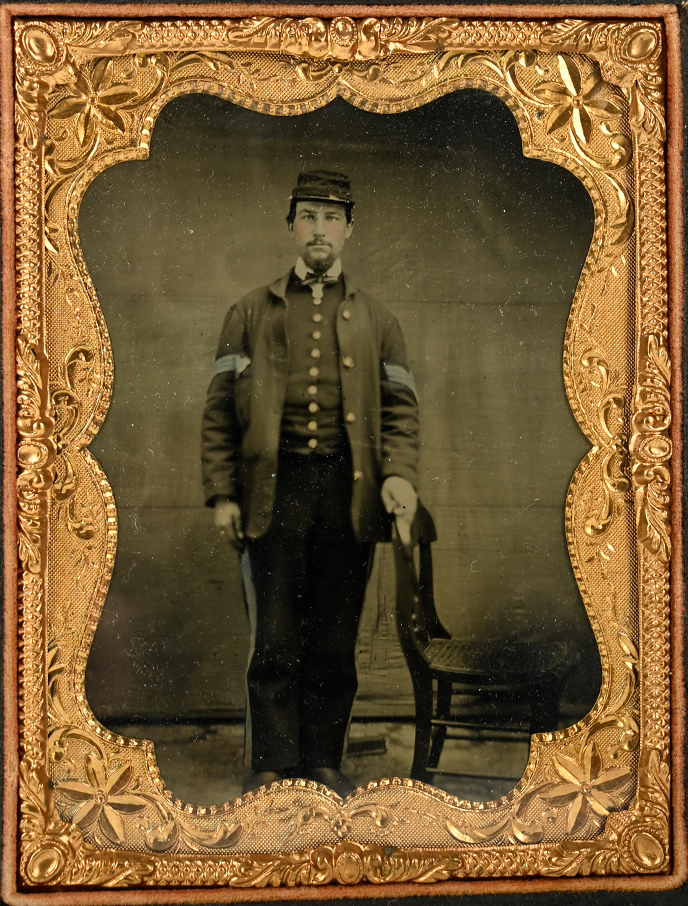site search
online catalog
IDENTIFIED BROOKS PATENT “WRITING, WORK AND TOILET CASE COMBINED,” OF SERGT. ENOCH JOY, 18th NEW HAMPSHIRE, WITH HIS PHOTOGRAPH: EX-TEXAS CIVIL WAR MUSEUM

Hover to zoom























$5,950.00
Quantity Available: 1
Item Code: 1179-623
Shipping: Determined by Method & Location of buyer
To Order:
Call 717-334-0347,
Fax 717-334-5016, or E-mail
This is an excellent example of a Civil War soldier’s writing kit, one of several different designs marketed to new soldiers directly and through loved ones who wished them to write. The Brooks version also benefitted the soldier’s health and appearance by combining a “writing and toilet kit,” expanded in some ads to note it included a “work case” (i.e. sewing kit) as well, the whole also marketed as their, “Military and Travelling Writing, Work and Toilet Case.” This was the brainchild of brothers Lyman and D.B. Brooks, who ran a book and stationery store in Salem, Mass. Lyman filed the patent. D.B. did the advertising, which included the testimonial: “Your boy’s army outfit is not complete without it.” A General was cited as proclaiming that, "this case would be carried on the march, when the Knapsack would be left behind. . .” The inventors also noted, “It can be used on horseback,” which sounds, if possible, even less plausible.
This one was used, likely not on horseback, is nicely identified to a sergeant in the 18th New Hampshire, and retains lots of its contents in addition to the basic element- a cylindrical tin tray to hold some of the varied materials sold with it, the rest of which could then be rolled up around the tray and protected by a waterproof cover that was tied closed. This example includes the Brooks advertising label with January 1864 patent date, the outer flap, and the secondary inner flap with loops and narrow pockets for scissors, razor, comb, etc., along with a cloth flap for pins, and still has its sewing thimble. Items in the case include a small inkwell with screw top, two wood pen bodies, that would have had separate nibs, four sheets of patriotic writing paper, and also a paper checkerboard (for innocently whiling away down time in camp.) There are two skeins of thread, one blue and one white, a small wood cylinder with needles as well a light blue cloth securing several more, and a thimble on a cloth loop. The toiletry articles include a folding comb and pair of short scissors, with one arm squared off and beveled and the top flat serrated to act as a nail file also. Some items are missing, like the advertised envelopes and lead pencil, a razor or the promised toothbrush and tweezers, and others may come from later use at home, but it has far more of its contents than other examples we have seen and shows very well. It was formerly on display at the Texas Civil War Museum.
The kit is identified by the presence of a handwritten list of men in Company C of the 18th New Hampshire rolled up in the kit, broken down by sergeants, first, with their hometowns, including Enoch Joy of Ridgefield, and then privates grouped by hometown. In addition, there is full-standing quarterplate ambrotype of Joy, in cap and fatigue blouse with light-blue tinted sergeant’s stripes. This is housed in an embossed leatherette case with red facing pad and is nicely identified inside the back in period pencil: “Enoch Joy / Co. C 18 Regt. / N.H.V.” The name is tad light, but legible. The cover is separated on the hinge, but present. Behind the image in the case was a small twist of white thread, significance unknown. Joy is shown in front of a plain backdrop, with his hand resting on the back of a simple chair. He wears a mustache and goatee and is neatly attired with blouse open to show his vest, white shirt collar and striped bowtie. His trousers are dark and the sergeant’s stripes, like his chevrons are tinted light blue. His cheeks are slightly tinted red. The clarity is excellent.
Born in New Hampshire Dec. 30, 1837, Joy married in 1858 and is listed as farmer in Pittsfield in 1860. He enlisted in the army at age 27 on Sept. 2, 1864, mustering into Co. C of the 18th NH as a sergeant on Sept. 14. Only six companies, including Joy’s, had been completed when they were sent south and assigned to the Engineer Brigade of the Army of the Potomac at City Point, working on the fortifications there and then taking up position near Fort Davis at Petersburg on Dec. 10. They were transferred again, to work on fortifications at Bermuda Hundred from Dec. 18 to Feb. 5, 1865, and then returned to the Petersburg front where, having been joined by three more companies by March 19, they were assigned to the 9th Army Corps as infantry, were posted in support of a battery in the fighting at Fort Stedman on March 25, and joined the 3rd Brigade 1st Division. They held the fort to the fall of Petersburg, repelling a night attack on March 29 and taking part in the fighting on April 2 as the city fell. The regiment remained at Petersburg until April 20, returned to City Point until April 26, and then proceeded to Alexandria and Tennallytown, doing guard duty during the trial of the Lincoln conspirators, and finally mustering out in June and July, with Joy mustering out with Co. C on June 10, 1865.
Although enlisting from Pittsfield in 1864, Joy may already have been in the process of moving westward. He and his wife had a child in 1864, whose birthplace is listed as Grinnell, Iowa, and they all lived there later. He is picked up as a grocer there in 1880 and a poultry dealer in 1900. His wife had died there in 1899. He passed away at Grinnell in 1919.
This is great looking set, perfect for a display of a soldier’s personal items or a collection specifically devoted to letters and correspondence, or soldiers’ pastimes. [sr] [ph:m]
~~~~~~~~~~~~~~~~~~~~~~~~~~~~~~~~~~~
THIS ITEM, AS WITH ALL OTHER ITEMS AVAILABLE ON OUR WEB SITE,
MAY BE PURCHASED THROUGH OUR LAYAWAY PROGRAM.
CLICK HERE FOR OUR POLICIES AND TERMS.
THANK YOU!
Inquire About IDENTIFIED BROOKS PATENT “WRITING, WORK AND TOILET CASE COMBINED,” OF SERGT. ENOCH JOY, 18th NEW HAMPSHIRE, WITH HIS PHOTOGRAPH: EX-TEXAS CIVIL WAR MUSEUM
Most Popular
Historical Firearms Stolen From The National Civil War Museum In Harrisburg, Pa »
Theft From Gravesite Of Gen. John Reynolds »
Selection Of Unframed Prints By Don Troiani »
Fine Condition Brass Infantry Bugle Insignia »
Large English Bowie Knife With Sheath 1870’S – 1880’S »
Imported (Clauberg) Us Model 1860 Light Cavalry Officer's Saber »
featured item
DOUBLE CASED ¼ PLATE AMBROTYPES OF TWO MEMBERS BELIEVED TO BE OF THE ROME LIGHT GUARDS - COMPANY A, 8TH GEORGIA INFANTRY
These two fantastically clear images are housed together in a Union case that is also in excellent condition. Both sides show a beautiful scene of a lady riding a horse with a dog resting in front. Both subjects are unknown. The first image is of a… (846-517). Learn More »


